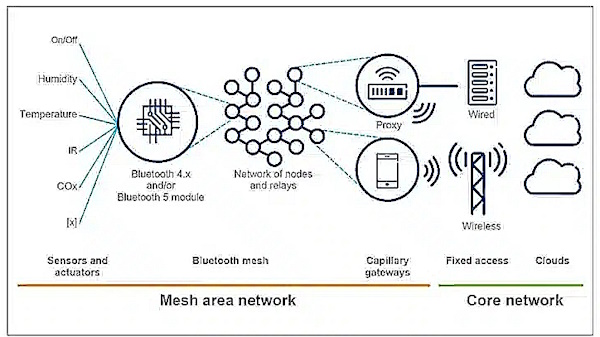
With a Range That Affects the Entire World, Skynet Infrastructure Is Now Fully in Place
[Truth Comes to Light editor’s note: All related to the rollout of Skynet, below you will find Patrick Wood’s (Technocracy News) commentary, a video by Rob Braxman (The Privacy Guy) and an article by Luis Quintero at The Conversation. You will also find link to a timetable for the rollout as posted by Android Authority (thanks to Sharon James for the heads up on this). ~ Kathleen ]
![]()
Skynet Has Arrived: Google Follows Apple, Activates Worldwide Bluetooth LE Mesh Network

commentary by Patrick Wood, Technocracy News editor
April 18, 2024
Wearables: Smartphones, fitness trackers, Smartwatches, hearing aids, Apple Air Tags, Ring products, etc., all use Bluetooth LE (low energy) to form an independent “mesh network” that is not based on the Internet. All these devices can receive, send, and forward data packets and instructions to other devices. Almost all IoT devices will be equipped with BLE. Thus, the INFRASTRUCTURE is complete, just waiting to sink its teeth into humanity everywhere.
Without AI running on massive computers, BLE would be a waste of time. Let me give you a simple example: CONTACT TRACING. With BLE, all other devices that you get close to can disclose frequency, length of contact, and other subsequent contacts that you make. Most BLE devices cannot be turned off, as in Apple Air-Tags. But Apple and Android Smartphones can transmit and receive BLE data even if the are turned OFF. (only a Faraday bag can stop transmission.)
So, the simple concept of Contact Tracing can be implemented during a future pandemic, documenting every person you have exposed and all you have been exposed to.
Mesh networks form spontaneously and dynamically, depending on how many devices are nearby. With the latest update, Bluetooth “long-range mode,” distances over 1 kilometer is possible. Eventually, collectors on the Internet will forward packets to who requested them in the first place. Returning instructions can be dropped back into the BLE mesh network for execution and control of devices.
Worse, BLE transmissions can blasted from space thanks to systems like Elon Musk’s SpaceX mesh network of satellites. To reiterate, BLE does not depend on the Internet or Internet addressing addresses.
Bottom line: The minimal infrastructure for Skynet is now in place. This a dark day for humanity.
![]()
Video available at Rob Braxman Tech Rumble & YouTube channels.
The last piece in the infrastructure that allows the operation of Skynet is now in place just announced a week ago. With this piece the advent of wireless peer to peer command and control of devices and robotics now become possible in full, with a range to affect all of the world.
See: There’s a Secret Network – Skynet 2.0 (more detailed explanation of BLE)
![]()
A new wave of wearable devices will collect a mountain on information on us – we need to get wise about the privacy implications
by Luis Quintero, The Conversation
April 17, 2024
Web and mobile services try to understand the desires and goals of users by analysing how they interact with their platforms. Smartphones, for instance, capture online data from users at a large scale and low cost.
Policymakers have reacted by enforcing mechanisms to mitigate the risks inherent in tech companies storing and processing their citizens’ private information, such as health data.
Wearable devices are now becoming a more significant element in this discussion due to their ability to collect continuous data, without the wearer necessarily being aware of it. Wearables such as smart watches gather an array of measurements on your wellbeing, such as sleep patterns, activity levels and heart fitness.
Today, there are portable devices to obtain high-quality data from brain activity, eye trackers, and the skin (to detect temperature and sweat). Consumers can buy small devices to measure the body’s responses that were exclusively available only to research institutions a few decades ago.
Although wearables are commercially focused on health monitoring, researchers have long envisioned capturing other kinds of data on a user. A computer that could collect useful information related to a person’s brain activity, heart and skin function, or their movement patterns would be able to understand a huge amount about the user.
But it’s AI that could prove a game changer. Smaller wearables combined with AI algorithms to process the data could produce tools that amplify and augment our goals and performance in life. But there are also downsides to all this information gathering.
Daily routines
Let’s imagine a world where wearables play a more prominent role daily. Smart beds could wake us up at the perfect time to feel rested by reading our body temperature, respiration and brain activity. Intelligent kitchens could help us eat more healthily, preparing a tailored diet based on chemical cues in our bloodstream (biomarkers). A smart bike would automatically change gears based on the changing inclination of the terrain, and on our fitness levels, to support an effective workout.
Smart glasses could analyse the responses of the pupils in our eyes and our overall eye movements to feed us content that we are likely to enjoy (supported by AI algorithms). Video calls could evolve into 3D full-body holograms of friends and family. Lastly, immersive entertainment could be projected in our living rooms or exist in headsets to become 360-degree experiences rather than being confined to flat screens.
Although it may seem futuristic, hardware manufacturers are already trying to move screens and devices out of our hands. For example, the Mobile World Congress 2024 showcased several smartwatches, an AI “pin” device made by the company Humane that can remove the need for a screen by projecting images onto the user’s hands, or the Air Glass 3 XR smart glasses.
Other companies have also recently released head-worn devices such as the Ray-Ban Meta, the Apple Vision Pro, or the Meta Quest 3. A device known as the Galea project is a kind of helmet that can be attached to XR headsets to capture data from facial muscles, the brain, eyes, the skin and heart.
This is clearly more invasive than a smart ring or smart glasses. It allows researchers to explore how future digital services might look if computers could access a range of data from the human body. This data would go far beyond what they can currently access – such as what we do on our smartphones.
In general, body data from wearables could fundamentally change how we interact with computers and the internet. In 2007, the audience at an Apple product launch was held in awe as Steve Jobs scrolled on an iPhone for the first time, introducing an intuitive interaction that the entire world would eventually take for granted.
Similarly, replacing smartphones with wearables and headsets would free up our hands and require new kinds of interaction with technology. Current prototypes propose using the gaze of our eyes to point and hand gestures in mid-air to click. However, this implies that these systems must continuously collect data on the user’s body.
Digital sovereignty
Large datasets based on responses from the human body could unlock the design of digital tools that weave seamlessly into our daily lives with capabilities that are highly personalised. This includes the smart bed and the intelligent kitchen that can suggest a tailored diet.
The next wave of the internet is being designed around data decentralisation – where users can potentially have greater control over how their data is used. This could prevent the misuse of personal information.
For example, the inventor of the World Wide Web, Tim Berners Lee, has been working on something called Solid. This open source initiative lets people handle their data in personal web servers and choose which organisations can access it.
Instead of making people create an account for each service they want to use, Solid would provide a protocol to build what the project refers to as personal online data stores. This would be a way to let users host their personal data on their own computer or, alternatively, choose a trusted provider to host it based on their reputation and physical location.
However, to really cement these initiatives, proactive legislation towards digital sovereignty – a person’s right to control their own digital data – would be required. This would guarantee an internet that truly takes privacy seriously.
In the era of wearables and powerful AI systems, a decentralised approach to the internet would be vital for letting citizens enjoy the benefits of these technological advances while continuing to own their data. This would move us towards the ability of citizens to make active decisions on where their data is stored, who can access it, and for what purposes.
See related (thanks to Sharon James for the heads on on this):
The article above is dated April 8, 2024. Here is an excerpt:
Google has finally switched on its upgraded Find My Device network. However, not everyone is lucky enough to enjoy it on day one of its launch. For now, Google is restricting the availability of the service to the US and Canada. Only Android users who live in these countries will get emails and on-device prompts to join the new crowdsourced network.
That said, sometime later this year, Google plans to roll out the upgraded Find My Device network worldwide. In an emailed statement to Android Authority, a Google representative confirmed that “the global rollout will be completed over the next couple of months.”
Cover image credit: David_SMC & Wikimedia Commons

Truth Comes to Light highlights writers and video creators who ask the difficult questions while sharing their unique insights and visions.
Everything posted on this site is done in the spirit of conversation. Please do your own research and trust yourself when reading and giving consideration to anything that appears here or anywhere else.










